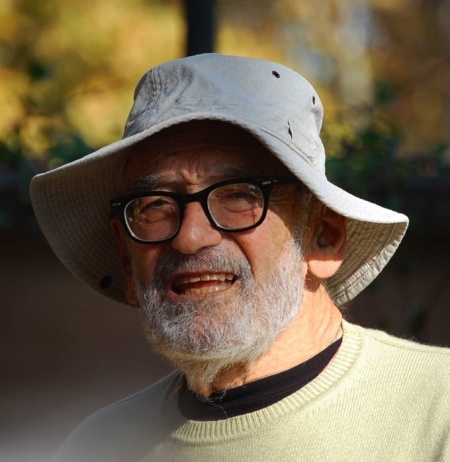 James Ackerman at the Villa Lante (Rome), October 2009
James Ackerman at the Villa Lante (Rome), October 2009
It can be confidently stated that the leading historian of Renaissance architecture and Italian Renaissance architectural theory is James Sloss Ackerman (FAAR’52, RAAR’65, ‘70, ‘75, ‘80), Trustee of the American Academy in Rome 1967-1984, and now Trustee Emeritus. As it happens, James Ackerman and his wife, artist and professor Jill Slosburg-Ackerman, are spending five weeks at the AAR this fall. During that time, he has delivered a lecture on “Michelangelo, Palladio and Public Magnificence” to a capacity audience in the Academy lecture room, and has participated in a wide range of less formal walks and talks in Rome. Plus, on 8 November, he celebrated his 90th birthday at the Academy.
James Ackerman was educated at Yale; his graduate work was at the Institute of Fine Arts, New York University, completing his degrees (MA 1947, PhD 1952) following World War II service in the US Army in Italy. From 1949 through 1952, he was a Fellow at the American Academy in Rome. Ackerman taught at Berkeley and from 1960 at Harvard as Arthur Kingsley Porter Professor of Fine Arts until his retirement in 1990. In an in-depth interview, AAR Arts and Humanities Intern Diana Mellon asks James Ackerman about his formative experiences in Italy, his fellowship years at the AAR, his perceptions of changes at the American Academy over the decades, and of larger developments in the field of architectural history. And following the interview is appended Ackerman’s own current “must see” list for Rome and Venice.
DM: Can you speak about your first encounters with Italy and your time here during the war? Where was architecture in your mind at that time, and how did your interest in it develop?
JSA: Well the first time I was 12 years old, so it was a very different kind of trip on that account. Just looking at things the way 12-year-olds do, without any particular focus or preparation for seeing anything. I remember practically nothing except the view out the hotel window onto the baths of Diocletian.
The next time was about ten years later, when I came to Italy as a soldier. I had prepared for enlistment by studying Russian in an army-supported program at Columbia University—very high pressure, eight hours a day. I was in that program for about three months and making tremendous progress. Then I was called up. So, first of all, when I was actually introduced to the specialty—it was cryptonalysis and cryptography—they weren’t interested in Russian at all, just wanted to know whether I’d rather do German or Japanese and I chose German, because it’s the major language of art history, and lost all the Russian right away.
We went first to England, then to Algeria, and then were transferred to Italy. We were initially in a major collecting point in Caserta, outside of Naples, and then in the course of the fall and winter 1944-45 we were posted in the Apennines because, being engaged in intercepting the communications of the Germans—and Italians of course, their allies—we had to be in heights. So I didn’t have much contact with Italian culture. A little bit with what life on a farm in the Apennines was like, that sort of thing.
In the spring of 1945 the Germans began to retreat. My company was entirely mobile, that is to say, all the operations, all the radio-receiving stuff and the kitchen and everything else was on the backs of two-ton trucks, so when the Germans started to retreat, we just moved forward on wheels and passed the infantry very quickly—and so we were among the first units to move north of Bologna (was where the front had been), and we continued north, crossing the Po river in a couple days. All along the way we were welcomed as liberators, although we barely knew how to carry a gun, much less to shoot it.
In that stretch of time my major achievement was getting permission, along with the fellow with whom I shared a pup tent, to go to the next town when the courier jeep went out to get instructions. So we buzzed along for a short time and arrived at a town that had a kind of a causeway leading across a body of water into its center. It turned out to be Mantua. We were dropped in the main square and the courier went on to some other place. The two of us were left standing in the middle of this vast space and there was nobody around. People gradually hesitantly emerged from the arcades around the edges; they didn’t know who we were. They had been given horrific information about the nature of the enemy, namely that they ate babies and stuff like that. So we turned out to be the liberators of Mantua. Instead of going sightseeing we were put at the edge of a victory column that wound its way through the city.
Then we moved on. From there we went way up to Lake Como and later settled in a town outside of Milan. I volunteered to work with the Monuments and Fine Arts Commission just established there because it was something to do—I was tired of playing cards, waiting to be returned to the States. So for not a very long time I was in Milan and the commission sent me daily to the Certosa of Pavia, a monastery not very far from Milan, where they’d stored archival materials for safety which they wanted to bring back to the city. All the hefting of the volumes was handled by Italians hired to do the moving, and I was only there to supervise. I walked around the monastery every day. I’d had a year of graduate work before I got into the army, so I was already committed to being an art historian, but I didn’t know what field it would be after only a year. But the experience of looking intensely at a building complex like that I found very engaging.
When I came back to the States, they rushed us back very early because they wanted to retrain us for the service in the Pacific with Japanese communications—a typically ridiculous order given that it would have taken us five to six years to learn enough Japanese to do the job. While I was on home-leave a couple of weeks in August of 1945, the bombs were dropped on Hiroshima and Nagasaki, and the Japanese surrendered shortly after. When I got back to Fort Dix in New Jersey, we were told that they didn’t know what to do with us, and we were demobilized. So I got right back to the fall semester of NYU graduate school and from there on I was a budding historian of architecture. This wasn’t due entire to the Certosa; I’d had a little encouragement jn my first year because I had had a course with Richard Krautheimer, who was a great architectural historian who worked on early Christian churches, in Rome, actually. The course was in Renaissance architecture, so I just merged into this specialty. Four years later I was married, had a child and won a Rome prize. This was the second year after the academy was closed from the beginning of the war until 1947. I came in 1949, so there had been actually only one year of operations before, and it was quite small at that time. There were very few funded fellowships compared to those now secured. Thank you, [AAR President] Adele [Chatfield-Taylor].
So there were maybe four visual artists: Concetta Scaravaglione, Norman Rubington, Mitchell Siporin. I was the only art historian. One couple was here doing art history but I don’t recall that they were regular Fellows, and then perhaps one in music, Alexei Haieff?. The total could have been under 12. The situation was quite different: the director, Laurance Roberts really set the Academy in a completely different direction from pre-war times; it had previously been a white, Protestant men’s club, basically—you can tell from the portraits that are in the [AAR] café. They all look as if they’re about to go out to play polo. It was just a privileged bunch of gentlemen.
Also the Academy had an entirely different orientation than before the war, when the Fellows in the arts were required to collaborate in a single program throughout the year and come up with a sort of a Beaux-Arts project completely worked out with sculpture and building and landscape architecture at the end of the year. Beginning with the postwar period, there were no requirements—the artists were expected to have something to show in the exhibition at the end of the year but that was about it. I was very fortunate because I got a Fulbright during my first year so I had a two-year academy appointment and I took the Fulbright in between the two (the people at the Academy kindly kept me on during the Fulbright year). I even had a second child in Rome. Rome was in disastrous form at this point. You could see it in the Italian realist movies of the postwar period. The poverty and the disorganization and all. (Continues.)
DM: How has the Academy’s relationship to the city changed since then?
JSA: It has sufficiently, I would say. At the time when I was a Fellow, there was only one fellow who could even speak Italian and there were no Italians coming here to be part of the group or even to visit. I myself, because I had a family and was full time engaged with that, didn’t make much of a contact with the city and its opportunities. We art historIans, worked at the Biblioteca Hertziana more than we did here (and I was working on the history of the Vatican—subsequently published by the Vatican Press), so that I used the library there as well, sometimes looking out the window to check parts of the building. This brought us into contact with a different community but it wasn’t primarily Italian. That’s always been a problem—this physical isolation from the city and then the cultural division. Also, Italy at that time was a lot more conservative socially, and on occasions when I would invite an Italian colleague to come here, he’d show up without his wife because one didn’t participate socially that way except with old friends. And also, actually, the Italians on the whole, like a lot of Western Europeans, were very much involved with old family and social relations of their childhood, so they had very little impetus to really make interchange with us. I did however form a lifetime bond with a Venetian art historian, Michelangelo Muraro, but that was not common.
DM: When you first came to the Academy, what was the position of the study of architectural history, and how has it changed over the decades?
JSA: Well, architectural history in Italy had been strangled by fascism. There was very little of interest going on in the field. It was quite amazing how little progress they’d made. Fascism also isolated the Italian intellectual and scholar from other cultures so that they didn’t learn languages. At that time more than ever if you couldn’t read German you couldn’t even be a proper art historian, particularly in Rome with the Hertziana, where they had a really highly sophisticated tool for research, and the Germans were outstanding in the field.
When I got launched on Palladio—this was not during my fellowship but during a later time I spent here—there was only one book on the subject. It was by a Neapolitan, Roberto Pane…his approach to architecture was more or less art appreciation and it was based primarily in what you could grasp by looking at things rather than combining that with also investigation into the documentary material and social, economic and political underpinnings. The chronology of Palladio was completely vague, apart from one amateur scholar in Vicenza by the name of Giangiorgio Zorzi, who had started to bring out archival material. But as far as real understanding of what any particular architecture was like, it just didn’t exist, in my field anyway. Baroque was equally uninvestigated. (Continues.)
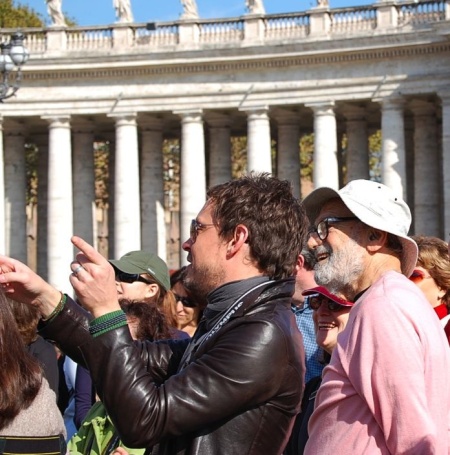 James Ackerman at St. Peter’s, discussing the facade with current Fellow Richard Wittman (left)
James Ackerman at St. Peter’s, discussing the facade with current Fellow Richard Wittman (left)
DM: You mentioned that observing buildings is important but so is looking at other kinds of archival material and developing your own ideas. In which of these areas do you think the Academy helped you, a historian at the beginning of his career?
JSA: Well, I would say—and I’m not particularly thinking of the work I was doing but rather of my orientation as a historian—being in a community with artists was very helpful because art historians are very often out of touch with the art of their contemporaries. It was important for me to be able to look at things with artists. I had one association here with Siporin and it was really good because we’d go places and look at things together. His responses were stimulating because they were very different from what we had had in the classroom. They, I think, widened my perspective. That was a good kind of offshoot of the life here.
DM: I’ve heard a lot about a well-loved photograph of you in the oculus of the Pantheon. Can you tell me the story behind it?
JSA: It could be a figment of the imagination! (Professor-in-Charge) Frank Brown…was a famous Yale archeologist and classicist who had been here for many years, during my entire fellowship and years later, and he took us up onto the roof of the Pantheon where we looked down from the oculus into the space. It was a terrifying experience. You know how you get vertigo from heights, right? I kind of inched up on my stomach and just got my eyebrows and eyes over the edge. The only way there could have been a photograph would have been the back of my head as I lay there. I never saw it. [We’ll find it—Ed.]
DM: You’ve been at the Academy every decade since you were a fellow in the 1940s up until the 1980s, and then again now. Why have you kept in such close contact with the Academy, and how has your relationship evolved?
JSA: The reason is that [Rome] was the focus of much of my early work and the first thing I did as a Fellow, and combined with my dissertation, was the work on the Vatican palace and the Cortile del Belvedere. The next thing I got into was the architecture of Michelangelo and that has very much of a Roman focus. And then on a subsequent visit to the Academy I had the manuscript of my Palladio book in rough form and spent most of the time here refining the writing, and this was an operation that was by no means common at that time. People wanted to get things out and whatever way the ideas spilled forth, they spilled forth. Because I was working on a project at Penguin Books to produce a series of paperbacks called “The Architect in Society,” I thought it was really important to write something which would have lasting value on account of its writing. While I’m not exactly embarrassed by what I wrote prior to that, this was really a focused effort to produce polished English (with the help of reading Edmund Wilson and George Orwell). And it paid off—the book has lasted without the text having been changed very much. (Continues.)
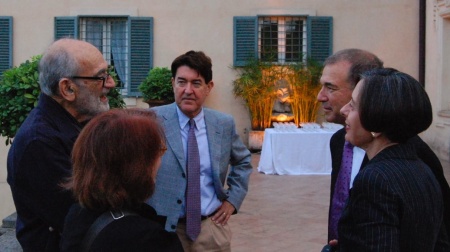 At the AAR’s Villa Aurelia (October 2009). From left, James Ackerman, Jill Slosburg-Ackerman, AAR Associate Director for External Affairs Bill Franklin, current Resident Stephen Greenblatt, AAR Director Carmela Vircillo Franklin (FAAR’85, RAAR’02)
At the AAR’s Villa Aurelia (October 2009). From left, James Ackerman, Jill Slosburg-Ackerman, AAR Associate Director for External Affairs Bill Franklin, current Resident Stephen Greenblatt, AAR Director Carmela Vircillo Franklin (FAAR’85, RAAR’02)
DM: Where does your field, architectural history, stand now?
JSA: It has been, like other fields in the humanities, greatly impacted by the kind of cultural wars of the ’70s and ’80s. That impact is most felt in architectural theory and understood in the architecture schools, where I felt that theory had gone into a kind of private realm of its own. There was a certain amount of that reflected in the practice of architectural history, but the field has broadened a great deal, and people are working on very different things than they did when I started. You don’t see the same preoccupation with what-happened-when, but much more in interpretive directions. I think this has been a healthy current.
On the other hand, in any field in the humanities there’s always a rather small number of people who have creative ideas, while the rest of the scholars have no ideas at all and just write what Michael Baxandall called chronicles—this happened, that happened, and then that happened. I would say the majority of people who are publishing in architectural history are doing chronicles. In the archival sense, fine, it doesn’t do any harm and it creates a kind of solid foundation of knowledge here and there, but it’s not inspiring or illuminating to read. You pick up the Journal of the Society of Architectural Historians and it’s very rarely that you want to read something there which impacts the entire field of architectural history and history in general.
I’ve always felt that I’m not committed to just architecture. I believe in the imagination going wherever you get the stimulus. In Italy there was a really important turnaround in the development of the school of architectural history in Venice, started by (Bruno) Zevi and really brought to great heights by (Manfredo) Tafuri, and that’s turned out really splendid people. Not only Italians, but quite a number of Americans have benefited from being there. It works very well to teach architectural history in the architecture schools in Italy.
In the States, it began to develop not very long ago. At Harvard there was always one architectural historian in the architecture school, and then there became a little coterie of architectural historians and people could get a PhD within the architecture school, although the degree can’t be authorized in a professional school but must be in arts and science. But that worked. And my first job, at Berkeley, after leaving here, was half architecture and half history of art; I started the architecture history program when I got there in 1952. I like teaching architecture students along with humanities students because they have a visual training that others don’t and also some of them can do very important work that people in history of art departments can’t do—in terms of technical investigation. I have one student from Harvard who’s done amazing work on proportion in Brunelleschi that has to do with geometrical analysis of the kind that I don’t know any professional art historian would be able to do. (Continues.)
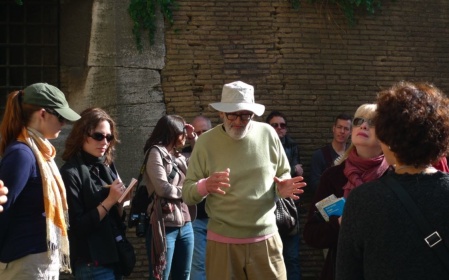 At the Porta San Spirito (Rome) with AAR Fellows, past and present, October 2009. Credit: Diana Mellon
At the Porta San Spirito (Rome) with AAR Fellows, past and present, October 2009. Credit: Diana Mellon
DM: One last question. On this visit to the academy, what strikes you as different in the experience of a Fellow here?
JSA: Well first of all, a lot of us are visitors. That constitutes quite a—…nobody visited in the past. It wasn’t even considered proper. If there were people it was only for a short time. I could see how the present situation, with maybe between a third and a half of the people here are people who are paying guests, that Fellows might feel that there are a lot of outsiders coming in and they might have a negative attitude towards it. But this is a particularly happy year because people are extremely congenial with one another and I’ve seen no signs of resentment against the visitors, who are mostly older and can serve as resources, in a way, for younger fellows at the Academy. And also it’s very different to have Italian artists and scholars attached to the Academy. It gives one stimulus to interaction and to learn the language.
Postscript: James Ackerman’s what-to-see-in Rome (and Venice) list
[Note: the accompanying links below were chosen by the SOF Weblog, solely to provide precise locations and addresses—Ed.]
“TO SEE IN ROME: Get to the following on the bus from the American Academy? Go to the ATAC Roma website, click on the British Flag, then “calculate route”, fill first blank with “Via G. Carini”, and blank below with street or place of destination. You get a map of the bus line(s) and the bus numbers.
“St. Ignazio (the perspective ceiling; the Baroque piazza); the Doria-Pamphili painting gallery nearby off the Corso. Both are near Piazza Venezia. Villa Borghese Museum (reserve on the web or by telephone; tickets have to be picked up a half hour before you can get in). Presently in addition to the great collection, a Caravaggio show partly marred by a stupid effort to compare him to Francis Bacon. Cortona ceiling in the Barberini Palace.
“Castel S. Angelo, in Vatican area. Vatican: the lines can be horrendously long, like 2 hours. Maybe get there there ½-1 hour before opening. Or wait ‘til cold weather. Inside of St. Peter: Michelangelo Pietà, Bernini Tabernacle and papal tomb, and sunburst in the apse.
“Villa Giulia, papal villa with great Etruscan museum. Great Roman museum by RR station (Termini), across from Baths of Diocletian in Palazzo Massimo. Don‘t miss painting top floor. Aside from the painting, I prefer the museum at Palazzo Altemps, beyond the river end of Piazza Navona. It’s a great Ludovisi collection from the 18th century in a Renaissance Palace, much more congenial in its spaces, great works and labels that show how much of them is restoration. Many rooms have sixteenth-century frescoes; be sure to see the “Ludovisi Throne.” Crypta Balbi museum on Via Botteghe Oscure (connecting Largo Argentina with Piazza Venezia). If the Farnese Palace is open, Caracci rooms at rear. Piazza Navona and nearby S. Luigi de’ Francesi chapel of Caravaggio (now closed for restoration). Michelangelo Moses in S. Pietro in Vincoli off Via Nazionale.
“Capitoline Hill—the museum of ancient sculpture and painting galleries in the Palazzo dei Conservatori there. (Currently there is an) exhibition of Michelangelo architecture in Rome. Forum Romanum: maybe it’s enough to survey it from behind the Capitoline hill, though you should go to the Imperial palaces on the Palatine hill for which you use the same ticket as for the Forum.
“Starting at Quirinal Palace in the square with the two giant horse trainers, see current show in the Scuderie museum across from the Palace of the President with great Roman painting. Continue past the side of the palace on Via del Quirinale, look into Baroque churches of Bernini (S. Andrea) and Borromini (S. Carlo), then continue along the same street, now named XX Settembre about 3 blocks to church of Sta. Maria della Vittoria on the first large square to see chapel with Bernini’s Ecstasy of Sta. Teresa.
“The best medieval mosaics: Sta. Prassede, a block west of the piazza before S. Maria Maggiore, especially the small chapel on the side-entrance side where they keep the supposed column on which Christ was flogged. Also apse mosaics: Church of SS Cosma & Damiano alongside Forum; S. Maria Maggiore very early along nave, later in apse. Best Cosmati pavement in striking old Christian church Sta. Maria in Cosmedin, by Bocca della Verità stop of bus 44. Also see Sta. Maria in Trastevere.
“S.Clemente, the church with three levels, near Colosseum. Fortified church, Quattro Coronati, is nearby to the right along street from S. Clemente going away from Colosseum. Ara Pacis on Tiber not far from Piazza del Popolo, in new (inappropriate) enclosure by Richard Meier.
“Baths of Caracalla: pass through the Porta S. Sebastiano onto the Via Appia, go straight at the Y to have a look at the Fosse Ardeatine, the monument built to commemorate where the 320 hostages were shot during WW2 by German soldiers in response to the bombing of 32 SS officers by partisans.
“Outside walls to the east, Church of Sta. Costanza (there’s also a catacomb under the church next door, but not one of the best).
“Out of town: Tivoli, Hadrian’s Villa and Medici Gardens (in town). Ostia, best surviving town after Pompeii. Next to the airport, a characteristic Roman town. Accessible by subway; half-a-day. Cerveteri or better Tarquinia, Etruscan tombs with wall paintings. With car, Bagnaia, Villa Gamberaia-Lante, Caprarola Villa.
“TO SEE IN VENICE (2/3 days). Buy ferry passes for as many days as you will be there.
“The Accademia. Exhibition in Palazzo Fortuny, remarkable collection of contemporary art, some past. Exhibit of John Wesley in Prada galleries on Isola S. Giorgio, across canal from San Marco piazza. Take ferry #2, one stop. Scuola di San Rocco: Tintoretto. Frari church opposite: Titian Paintings. Scuola De’ Schiavoni: Carpaccio paintings; see upper floor as well. S. Zaccaria: Bellini altarpiece, Chapel in rear left, a charge to enter.
“If time allows, a boat to Torcello. Allow 40 minutes. Stop in Murano on the way back if you want to buy any glass, cheaper than in Venice.”
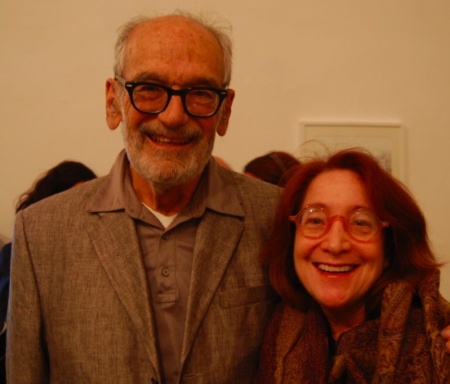 James Ackerman and Jill Slosburg-Ackerman at the opening of current Fellow Terry Adkins’ Meteor Stream exhibition (16 October 2009).
James Ackerman and Jill Slosburg-Ackerman at the opening of current Fellow Terry Adkins’ Meteor Stream exhibition (16 October 2009).
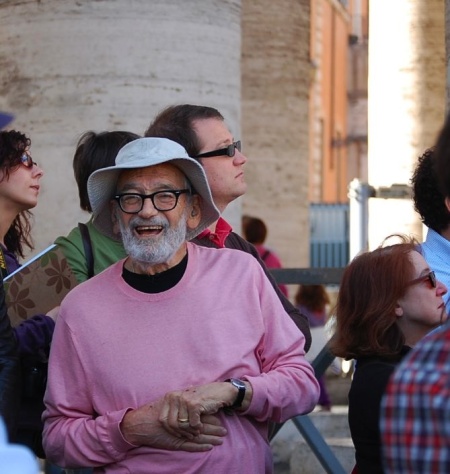
March 21, 2010 at 4:59 am |
James Ackerman’s reference to composer Alexei Haieff reminded me that Alexei Haieff was in residence at the American Acadamy in Rome
in 1950 when he composed his famous Concerto for Piano and Orchestra.
He was there with his friend pianist Leo Smit, for whom he composed the Piano Concerto. Recent CDs of Alexei Haieff’s works are becoming available by way of the website {www.alexei.com}
Andreixx 3/20/2010
March 21, 2010 at 5:04 am |
These are the first CDs of composer Alexei Haieff that have been since 1995 , when BMG released “Princess Zondilda and Her Entourage” on the CD “Music for Merce”. These current CDs are “Kirill and Anna Gliadkovsky Play Alexei Haieff” and ” Manhattan Piano”. It is important that this information become available to the public. Alexei Haieff is a distinguished former resident of the American Academy in Rome and his music must be more widely distributed on CD. Alexei Haieff is buried at the Cimiterio Acatolico in Rome where he died in 1994.
andreixx 3/20/2010
andre@alexei.com
Andre Haeff